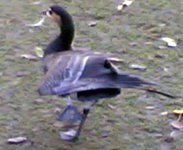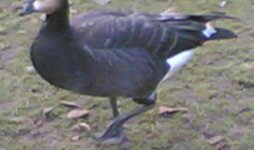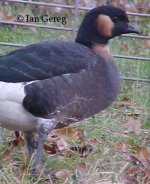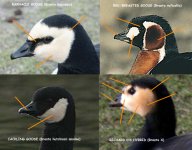-
Welcome to BirdForum, the internet's largest birding community with thousands of members from all over the world. The forums are dedicated to wild birds, birding, binoculars and equipment and all that goes with it.
Please register for an account to take part in the discussions in the forum, post your pictures in the gallery and more.
You are using an out of date browser. It may not display this or other websites correctly.
You should upgrade or use an alternative browser.
You should upgrade or use an alternative browser.
Escapee? Wildfowl (1 Viewer)
- Thread starter Richard D
- Start date
More options
Who Replied?London Birder
Well-known member
Richard D said:Presumably an escapee - but what is it? Slightly larger than a Mallard, but a far more slender build.
Thanks
looks like a Barnacle x Brent Goose hyb ... or something like that
Joern Lehmhus
Well-known member
Hi,
I´d agree with you, Vincent,
that ´s a Barnacle x Hawaiian goose hybrid!
Richard, I would also be interested to see more shots!
Joern
I´d agree with you, Vincent,
that ´s a Barnacle x Hawaiian goose hybrid!
Richard, I would also be interested to see more shots!
Joern

Vinch said:Do you have some other pics of this goose, especially the head, Richard?
Sorry - these were the best I could grab with the phone (and at full zoom hence the quality). The bird was unringed but seemed far too tame to be anything but an escapee - plus I couldn't recognise it! I wondered whether it might be a juvenile, but that's just an impression rather than based on knowledge. It was feeding with a group of Mallards (semi-feral Mallards). Other than it having what seemed a very small bill for a goose and the face was a lovely gold colour I'm not sure I can add much to the description of the face. Size wise I guess the bird was that of a smallish Brent, and I think there was white to the rump.

Richard D said:Sorry - these were the best I could grab with the phone (and at full zoom hence the quality). The bird was unringed but seemed far too tame to be anything but an escapee - plus I couldn't recognise it! I wondered whether it might be a juvenile, but that's just an impression rather than based on knowledge. It was feeding with a group of Mallards (semi-feral Mallards). Other than it having what seemed a very small bill for a goose and the face was a lovely gold colour I'm not sure I can add much to the description of the face. Size wise I guess the bird was that of a smallish Brent, and I think there was white to the rump.
Vinch / Joern checked my phone and found one other photo:
Thanks for the ID.
Attachments
London Birder
Well-known member
well ... Barnacle for sure
Vincent and everyone else, why do you think that the bird is an nene x barnacle hybrid for sure? Because of the cheeks' colour? What if the cheeks are stained? The feet do not seem to show ''nene-ish'' characteristics, the neck does not seem to show any signs of being furrowed and the colour of the bird's breast and belly are very dark which I would not expect from a Nene X Barnacle hybrid.
I am unexperienced and you surely have good reasons to believe that it is a Nene X Barnacle, but I do not know what these reasons are and do not understand why it HAS to be a N X B. Perhaps someone can explan it to me?
I am unexperienced and you surely have good reasons to believe that it is a Nene X Barnacle, but I do not know what these reasons are and do not understand why it HAS to be a N X B. Perhaps someone can explan it to me?
Joern Lehmhus
Well-known member
kosmos said:Vincent and everyone else, why do you think that the bird is an nene x barnacle hybrid for sure?
Perhaps someone can explan it to me?
Hi Kosmos,
Barnacle goose hybrids are often (but not always) quite dark birds.
For example Barnacle goose hybrids with Bar-headed goose, Emperor goose, Lesser Whitefronted goose, Snow and Ross goose are generally dark birds, also some Barnacle Goose x Canada goose hybrids are darker than one would expect from the parents.
The hybrid in question clearly involves Barnacle goose from the overall pattern and coloration;
for example the black breast of Barnacle goose is a dominant feature that is generally expressed in Barnacle Goose Hybrids and also shown here.
The reduced webbing in the feet of Hawaiian goose was not expressed in those Hawaiian goose hybrids where I saw pictures of the feet (Hawaiian Goose x Emperor Goose and Hawaiian Goose x Coscoroba Swan)–these hybrids had fully webbed feet.
The hybrid Richard photographed looks longlegged and longtailed to me - features that fit well with Hawaiian Goose. Also the greater coverts on the wing are mainly uniformely coloured but with a clear white tip, and the face is a golden brown coloration. This also suggests Hawaiian goose.
The slender build Richard mentions also points to Hawaiian goose as one parent.
I doubt the golden brown facial coloration is staining. The typical staining you see in geese with a white face is either uniform in coloration over the whole face or darkest around the bill and fading the more you go towards the back of the head.
The hybrid in question is white around the base of the bill and the facial coloration becomes darker towards the back of the head.
However, allthough Vincent and I both have some experience with hybrid waterfowl and reached the same conclusion independently, we still could be wrong.
One has to keep in mind that hybrids of two species are generally much more variable than a species itself...
Jörn

Joern Lehmhus said:Hi Kosmos,
Barnacle goose hybrids are often (but not always) quite dark birds.
For example Barnacle goose hybrids with Bar-headed goose, Emperor goose, Lesser Whitefronted goose, Snow and Ross goose are generally dark birds, also some Barnacle Goose x Canada goose hybrids are darker than one would expect from the parents.
The hybrid in question clearly involves Barnacle goose from the overall pattern and coloration;
for example the black breast of Barnacle goose is a dominant feature that is generally expressed in Barnacle Goose Hybrids and also shown here.
The reduced webbing in the feet of Hawaiian goose was not expressed in those Hawaiian goose hybrids where I saw pictures of the feet (Hawaiian Goose x Emperor Goose and Hawaiian Goose x Coscoroba Swan)–these hybrids had fully webbed feet.
The hybrid Richard photographed looks longlegged and longtailed to me - features that fit well with Hawaiian Goose. Also the greater coverts on the wing are mainly uniformely coloured but with a clear white tip, and the face is a golden brown coloration. This also suggests Hawaiian goose.
The slender build Richard mentions also points to Hawaiian goose as one parent.
I doubt the golden brown facial coloration is staining. The typical staining you see in geese with a white face is either uniform in coloration over the whole face or darkest around the bill and fading the more you go towards the back of the head.
The hybrid in question is white around the base of the bill and the facial coloration becomes darker towards the back of the head.
However, allthough Vincent and I both have some experience with hybrid waterfowl and reached the same conclusion independently, we still could be wrong.
One has to keep in mind that hybrids of two species are generally much more variable than a species itself...
Jörn
Thanks Jörn,
The facial colouration was clearly natural as opposed to staining. I haven't a clue where it came from - I don't know of any collections near by.
Regards Richard
Joern Lehmhus
Well-known member
Hi Richard and all others,
Above things said, I am looking at the third pic Richard found on his mobile and there is something on that,
which lets me think of another possibility:
The feathers on the back of the neck look slightly longish (mane –like) usual and the bill is really small, together with the dark appearance.
Therefore I can not fully exclude a hybrid Barnacle goose x Redbreasted goose (never saw a photo of that and as far as I know Redbreasted geese do rarely hybridize).
But attached is a photo from the web showing a Cackling Goose x Redbreasted goose, which shows a similar cheek coloration.
So if anybody near that location could get some better photos, I´d be really happy!!!
Above things said, I am looking at the third pic Richard found on his mobile and there is something on that,
which lets me think of another possibility:
The feathers on the back of the neck look slightly longish (mane –like) usual and the bill is really small, together with the dark appearance.
Therefore I can not fully exclude a hybrid Barnacle goose x Redbreasted goose (never saw a photo of that and as far as I know Redbreasted geese do rarely hybridize).
But attached is a photo from the web showing a Cackling Goose x Redbreasted goose, which shows a similar cheek coloration.
So if anybody near that location could get some better photos, I´d be really happy!!!
Attachments
Vinch
Vinch
Hi Jorn,
I saw three Ross's X Red-Breasted hybrids in a french zoo, but, unfortunately, not photographied.
At their young plumage, these hybrids showed red-breasted pattern (grey instaed copper-brown) on their flanks and their neck. Their back and theirs wings were bronw-grey and their bill and legs were blackish.
When these birds became adults, their plumage became almost completely white, with some grey patches on their back and neck. Legs became greyish-pink, and bill pink at the point.
Their calls were similar to Red-Breasted.
About Richard's hybrid, I think strongly, for the same reasons you gave, that this bird is a hawaiian/ barnacle hybrid.
About Coscoraba/hawaiian hybrid, you told about Eric&Barry Gilham hybrid?
I cannot believe that this bird was a coscoroba/hawaiian hybrid, but, as the other coscoroba hybrid, a blue steinbacher Goose (domestic bred)/ coscoroba swan hybrid.
My reasons?
At first, the strong similarities between the two birds...
And, the blue gene is dominant to the normal coloration gene (normal colored steinbacher geese exist...). So, normal coloration gene would be lasked by blue gene and you may have this explanation about different colorations between these two hybrids..
And, as far as I remember (I don't have this book at the moment), the Coscoroba was the male and I think, for too important weight and height differences, it would be quite impossible for a male Coscoroba to mate a female Hawaiian...
It is more possible with a female Steinbacher goose.
I saw three Ross's X Red-Breasted hybrids in a french zoo, but, unfortunately, not photographied.
At their young plumage, these hybrids showed red-breasted pattern (grey instaed copper-brown) on their flanks and their neck. Their back and theirs wings were bronw-grey and their bill and legs were blackish.
When these birds became adults, their plumage became almost completely white, with some grey patches on their back and neck. Legs became greyish-pink, and bill pink at the point.
Their calls were similar to Red-Breasted.
About Richard's hybrid, I think strongly, for the same reasons you gave, that this bird is a hawaiian/ barnacle hybrid.
About Coscoraba/hawaiian hybrid, you told about Eric&Barry Gilham hybrid?
I cannot believe that this bird was a coscoroba/hawaiian hybrid, but, as the other coscoroba hybrid, a blue steinbacher Goose (domestic bred)/ coscoroba swan hybrid.
My reasons?
At first, the strong similarities between the two birds...
And, the blue gene is dominant to the normal coloration gene (normal colored steinbacher geese exist...). So, normal coloration gene would be lasked by blue gene and you may have this explanation about different colorations between these two hybrids..
And, as far as I remember (I don't have this book at the moment), the Coscoroba was the male and I think, for too important weight and height differences, it would be quite impossible for a male Coscoroba to mate a female Hawaiian...
It is more possible with a female Steinbacher goose.
Joern Lehmhus
Well-known member
Vinch said:Hi Jorn,
I saw three Ross's X Red-Breasted hybrids in a french zoo, but, unfortunately, not photographied.
At their young plumage, these hybrids showed red-breasted pattern (grey instaed copper-brown) on their flanks and their neck. Their back and theirs wings were bronw-grey and their bill and legs were blackish.
When these birds became adults, their plumage became almost completely white, with some grey patches on their back and neck. Legs became greyish-pink, and bill pink at the point.
Their calls were similar to Red-Breasted.
About Richard's hybrid, I think strongly, for the same reasons you gave, that this bird is a hawaiian/ barnacle hybrid.
About Coscoraba/hawaiian hybrid, you told about Eric&Barry Gilham hybrid?
I cannot believe that this bird was a coscoroba/hawaiian hybrid, but, as the other coscoroba hybrid, a blue steinbacher Goose (domestic bred)/ coscoroba swan hybrid.
My reasons?
At first, the strong similarities between the two birds...
And, the blue gene is dominant to the normal coloration gene (normal colored steinbacher geese exist...). So, normal coloration gene would be lasked by blue gene and you may have this explanation about different colorations between these two hybrids..
And, as far as I remember (I don't have this book at the moment), the Coscoroba was the male and I think, for too important weight and height differences, it would be quite impossible for a male Coscoroba to mate a female Hawaiian...
It is more possible with a female Steinbacher goose.
Hi Vincent,
I think we cannot be 100% sure from the photos concerning Richards Hybrid, but Barnacle x Hawaiian goose just fits best.....
Concerning the Hybrid in the Gillham book, I think it was in the category "both parents known"...have to check this, but I don´t have enough experience with Coscoroba hybrids to give a safe vote there what the other parent was...However I think size differences do not matter that much in hybrids of Anatidae (just think of teal x mallard hybrids)
Joern

Joern Lehmhus said:Hi Vincent,
I think we cannot be 100% sure from the photos concerning Richards Hybrid, but Barnacle x Hawaiian goose just fits best.....
Concerning the Hybrid in the Gillham book, I think it was in the category "both parents known"...have to check this, but I don´t have enough experience with Coscoroba hybrids to give a safe vote there what the other parent was...However I think size differences do not matter that much in hybrids of Anatidae (just think of teal x mallard hybrids)
Joern
Thanks again Gentlemen - I'll keep my eyes open at the weekend and see if I can better photos (I'll try and remember the camera as well as the phone!).
Richard
Joern Lehmhus
Well-known member
Dear Richard,
Vinch has sent me the pics you took the last weekend, and i must say that is a really interesting bird! It does look less like a hawaiian x barnacle goose hybrid than I had thought before, but there is some similarity to the cackling goose x red-breasted goose hybrid .
especially that the bird is really that dark (It didn´t look that dark on your first pics) and that the front part of the face is white lets me tend much more towards barnacle x bredbreasted goose.
This in short; another possibility Vinch mentioned was that it could be a backcross- however, I will have to dig up some other hybirds for comparison....
this is indeed a tough nut! I´ll come back to this after doing some checking. Meanwhile many thanks that you took the effort and got some more photos.
Best wishes ,Jörn
Vinch has sent me the pics you took the last weekend, and i must say that is a really interesting bird! It does look less like a hawaiian x barnacle goose hybrid than I had thought before, but there is some similarity to the cackling goose x red-breasted goose hybrid .
especially that the bird is really that dark (It didn´t look that dark on your first pics) and that the front part of the face is white lets me tend much more towards barnacle x bredbreasted goose.
This in short; another possibility Vinch mentioned was that it could be a backcross- however, I will have to dig up some other hybirds for comparison....
this is indeed a tough nut! I´ll come back to this after doing some checking. Meanwhile many thanks that you took the effort and got some more photos.
Best wishes ,Jörn
Vinch
Vinch
Hello,
As Jörn said, I think about a back-croos hybrid. More exactly Barnacle X (Barnacle X Cackling), the cackling goose parent would be a very dark bird (Branta hutchinsii minima).
I don't agree Jörn about a possible Red-breasted X Barnacle. Because with plumages comparisons and superposition (Barnacle + Red-breasted), a Red-Breasted X Barnacle would show white or whitish areas in flanks, contrasting with dark-grey belly, and, especially,white feathers above the legs...
Best regards,
Vincent.
As Jörn said, I think about a back-croos hybrid. More exactly Barnacle X (Barnacle X Cackling), the cackling goose parent would be a very dark bird (Branta hutchinsii minima).
I don't agree Jörn about a possible Red-breasted X Barnacle. Because with plumages comparisons and superposition (Barnacle + Red-breasted), a Red-Breasted X Barnacle would show white or whitish areas in flanks, contrasting with dark-grey belly, and, especially,white feathers above the legs...
Best regards,
Vincent.
Joern Lehmhus
Well-known member
Hi Vinch,
How would you explain the cheek coloration and facial pattern then- I don´t see this as a hybrid involving cackling goose,even if it is a backcross...
Pro redbreased Goose hybrid:The darkness of the bird , the cheek coloration, the white at the base of the bill and the head shape could be interpreted in this direction; cackling x barnacle goose hybrids are much more brownish and have a different facial pattern...
A rad breasted x barnacle goose would not nessecarily show white on the flanks--barnacle goose hybrids tend to be relatively uniformely coloured there... so the bird might have got the dark on the flanks from ruficollis and the more uniform coloration (without the white border of ruficollis) from leucopsis.
I will give a more detailed answer next week... too much work awaiting me this afternoon...
Regards, Jörn
How would you explain the cheek coloration and facial pattern then- I don´t see this as a hybrid involving cackling goose,even if it is a backcross...
Pro redbreased Goose hybrid:The darkness of the bird , the cheek coloration, the white at the base of the bill and the head shape could be interpreted in this direction; cackling x barnacle goose hybrids are much more brownish and have a different facial pattern...
A rad breasted x barnacle goose would not nessecarily show white on the flanks--barnacle goose hybrids tend to be relatively uniformely coloured there... so the bird might have got the dark on the flanks from ruficollis and the more uniform coloration (without the white border of ruficollis) from leucopsis.
I will give a more detailed answer next week... too much work awaiting me this afternoon...
Regards, Jörn
Vinch
Vinch
Hi Jörn,
You may be right.
Points of right for you: white area between eye and bill, darkness, lacking of black bar from eye to bill, and cheek coloration.
But lacking of white areas on the flanks make a problem for me...
So, why excluding a backcross to Barnacle, with a involved dark Branta h.minima in first cross?
Some leucopsis are darker than other and show more creamy face, independantly from feeding habits or from any hybridization. I saw some very dark specimens in several zoo...
So, a backcross would make the cheek more creamy with addition of two dark factor (from Barnacle plus from cackling)
And plumage pattern of this hybrid looks very similar to a very dark Cackling goose's pumage, except black breast.
So, I'm according you in this case: the complete lacking of black bar between eye and bill make a problem.
And an other point in favor of a possible red-breasted goose/ Barnacle goose. Look at above the eye: there is a small black bar, which is very similar to black bar above the eye of red-breasted Goose...
Finally, I think you are right, Jörn: This bird would be a F1 (even a F2 to barnacle) Red-breasted/Barnacle goose hybrid...
Please find joined a comparison I made about points of discuss between Cackling, Barnacle, Red-Breasted and Richard D's hybrid.
(To see dark Minima:
http://www.idahobirds.net/identification/white-cheeked/subspecies.html
http://www.oceanwanderers.com/CAGO.Subspecies.html#cackling )
Best regards,
Vincent.
You may be right.
Points of right for you: white area between eye and bill, darkness, lacking of black bar from eye to bill, and cheek coloration.
But lacking of white areas on the flanks make a problem for me...
So, why excluding a backcross to Barnacle, with a involved dark Branta h.minima in first cross?
Some leucopsis are darker than other and show more creamy face, independantly from feeding habits or from any hybridization. I saw some very dark specimens in several zoo...
So, a backcross would make the cheek more creamy with addition of two dark factor (from Barnacle plus from cackling)
And plumage pattern of this hybrid looks very similar to a very dark Cackling goose's pumage, except black breast.
So, I'm according you in this case: the complete lacking of black bar between eye and bill make a problem.
And an other point in favor of a possible red-breasted goose/ Barnacle goose. Look at above the eye: there is a small black bar, which is very similar to black bar above the eye of red-breasted Goose...
Finally, I think you are right, Jörn: This bird would be a F1 (even a F2 to barnacle) Red-breasted/Barnacle goose hybrid...
Please find joined a comparison I made about points of discuss between Cackling, Barnacle, Red-Breasted and Richard D's hybrid.
(To see dark Minima:
http://www.idahobirds.net/identification/white-cheeked/subspecies.html
http://www.oceanwanderers.com/CAGO.Subspecies.html#cackling )
Best regards,
Vincent.
Attachments
Users who are viewing this thread
Total: 2 (members: 0, guests: 2)






![13112005_001_[1].jpg](/data/attachments/30/30952-b43b46166f552a45ac55ad1d36afbd58.jpg)

